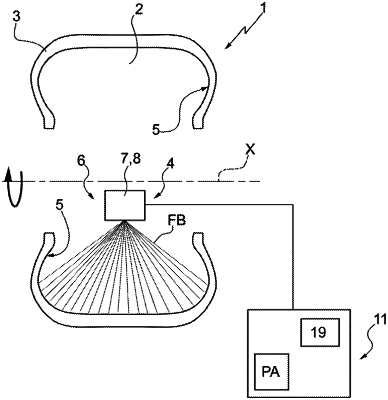| CPC B29D 30/0685 (2013.01) [B29C 73/22 (2013.01); B29D 2030/0694 (2013.01)] | 10 Claims |

|
1. A system for applying a sealing agent to a surface of an internal cavity of a pneumatic tire; the system comprises:
a frame upon which the pneumatic tire is arranged, wherein the frame is configured to rotate the pneumatic tire around a first (x) axis thereof, and to prevent lateral translation of the pneumatic tire along the first axis during the rotation;
an applicator device comprising a nozzle configured to apply a strip of sealing agent to the surface;
an optoelectronic device that is movable independent of the applicator device and provided with at least one sensor element that is able to capture a plurality of images of the entire surface and to provide a plurality of signals that are indicative of the plurality of captured images; and
an electronic processing system, which is connected to the optoelectronic device and to the applicator device, wherein the electronic processing system is configured to:
insert the optoelectronic device into the internal cavity of the pneumatic tire;
rotate the pneumatic tire at least 360 degrees about the optoelectronic device, to acquire the signals that are indicative of the plurality of captured images and to perform a three-dimensional surface scan of a plurality of portions of the surface that are uniformly distributed 360 degrees about the first axis, and thereby identify x, y, and z reference coordinates of a plurality of points into which each portion is divided as a function of the respective images;
determine a profile of an interior surface of the tire from the plurality of captured images and the identified x, y, and z reference coordinates;
extract the optoelectronic device from the internal cavity of the pneumatic tire upon completion of the three-dimensional surface scan;
calculate movement of the applicator device throughout application of the strip of sealing agent as a function of the identified three-dimensional reference coordinates of the entire internal cavity to maintain a constant distance between the applicator device and the surface; and
insert the applicator device into the internal cavity, and upon insertion of the applicator device to drive the applicator device as a function of the calculated movements.
|